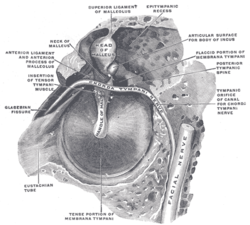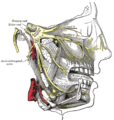| Chorda tympani | |
|---|---|
 The left tympanic membrane with the malleus and the chorda tympani, viewed from within the tympanic cavity (medial). The left tympanic membrane with the malleus and the chorda tympani, viewed from within the tympanic cavity (medial). | |
| Details | |
| From | Facial nerve |
| Innervates | Taste (anterior 2/3 of tongue) Sublingual gland |
| Identifiers | |
| Latin | nervus chorda tympani |
| MeSH | D002814 |
| TA98 | A14.2.01.084 A14.2.01.118 |
| TA2 | 6292 |
| FMA | 53228 |
| Anatomical terms of neuroanatomy[edit on Wikidata] | |
Chorda tympani is a branch of the facial nerve that carries gustatory (taste) sensory innervation from the front of the tongue and parasympathetic (secretomotor) innervation to the submandibular and sublingual salivary glands.
Chorda tympani has a complex course from the brainstem, through the temporal bone and middle ear, into the infratemporal fossa, and ending in the oral cavity.
Structure
Chorda tympani fibers emerge from the pons of the brainstem as part of the intermediate nerve of the facial nerve. The facial nerve exits the cranial cavity through the internal acoustic meatus and enters the facial canal. Within the facial canal, chorda tympani branches off the facial nerve and enters the lateral wall of the tympanic cavity within the middle ear, where it runs across the tympanic membrane (from posterior to anterior) and medial to the neck of the malleus.
Chorda tympani then exits the skull by descending through the petrotympanic fissure into the infratemporal fossa. Here it joins the lingual nerve, a branch of the mandibular nerve (CN V3). Traveling with the lingual nerve, the fibers of chorda tympani enter the sublingual space to reach the anterior 2/3 of the tongue and submandibular ganglion.
- The special sensory fibers originate from the taste buds in the anterior 2/3 of the tongue and carry taste information to the nucleus of solitary tract of the brainstem, where taste information from facial, glossopharyngeal, and vagus nerves is integrated.
- The preganglionic parasympathetic fibers originate in the superior salivary nucleus of the brainstem and project to the submandibular ganglion to synapse with postganglionic fibers which go on to innervate the submandibular and sublingual salivary glands.
Function
The chorda tympani carries two types of nerve fibers from their origin from the facial nerve to the lingual nerve that carries them to their destinations:
- Special sensory fibers providing taste sensation from the anterior two-thirds of the tongue.
- Preganglionic parasympathetic fibers to the submandibular ganglion, providing secretomotor innervation to two salivary glands: the submandibular gland and sublingual gland and to the vessels of the tongue, which when stimulated, cause a dilation of blood vessels of the tongue.

Taste
The chorda tympani is one of three cranial nerves that are involved in taste. The taste system involves a complicated feedback loop, with each nerve acting to inhibit the signals of other nerves.
There are similarities between the tastes the chorda tympani picks up in sweeteners between mice and primates, but not rats. Relating research results to humans is therefore not always consistent. Sodium chloride is detected and recognized most by the chorda tympani nerve. The recognition and responses to sodium chloride in the chorda tympani is mediated by amiloride-sensitive sodium channels. The chorda tympani has a relatively low response to quinine and varied responses to hydrochloride. The chorda tympani is less responsive to sucrose than is the greater petrosal nerve.
Chorda tympani transection
The chorda tympani nerve carries its information to the nucleus of solitary tract, and shares this area with the greater petrosal, glossopharyngeal, and vagus nerves. When the greater petrosal and glossopharyngeal nerves are cut, regardless of age, the chorda tympani nerve takes over the space in the terminal field. This takeover of space by the chorda tympani is believed to be the nerve reverting to its original state before competition and pruning. The chorda tympani, as part of the peripheral nervous system, is not as plastic in early ages. In a study done by Hosley et al. and a study done by Sollars, it has been shown that when the nerve is cut at a young age, the related taste buds are not likely to grow back to full strength. In a bilateral transection of the chorda tympani in mice, the preference for sodium chloride increases compared to before the transection. Also avoidance of higher concentrations of sodium chloride is eliminated. The amiloride-sensitive channels responsible for salt recognition and response is functional in adult rats but not neonatal rats. This explains part of the change in preference of sodium chloride after a chorda tympani transection. The chorda tympani innervates the fungiform papillae on the tongue. According to a study done by Sollars et al. in 2002, when the chorda tympani has been transected early in postnatal development some of the fungiform papillae undergo a structural change to become more “filiform-like”. When some of the other papillae grow back, they do so without a pore.
Dysfunction
| This section needs expansion. You can help by adding to it. (March 2018) |
Injury to the chorda tympani nerve leads to loss or distortion of taste from anterior 2/3 of tongue. However, taste from the posterior 1/3 of tongue (supplied by the glossopharyngeal nerve) remains intact.
The chorda tympani appears to exert a particularly strong inhibitory influence on other taste nerves, as well as on pain fibers in the tongue. When the chorda tympani is damaged, its inhibitory function is disrupted, leading to less inhibited activity in the other nerves.
Additional images
| This gallery of anatomic features needs cleanup to abide by the medical manual of style. Galleries containing indiscriminate images of the article subject are discouraged; please improve or remove the gallery accordingly. (May 2015) |
-
 Mandible of human embryo 24 mm. long. Outer aspect.
Mandible of human embryo 24 mm. long. Outer aspect.
-
 Distribution of the maxillary and mandibular nerves, and the submaxillary ganglion.
Distribution of the maxillary and mandibular nerves, and the submaxillary ganglion.
-
 Plan of the facial and intermediate nerves and their communication with other nerves.
Plan of the facial and intermediate nerves and their communication with other nerves.
-
 The course and connections of the facial nerve in the temporal bone.
The course and connections of the facial nerve in the temporal bone.
-
 Sympathetic connections of the submaxillary and superior cervical ganglia.
Sympathetic connections of the submaxillary and superior cervical ganglia.
-
 View of the inner wall of the tympanum (enlarged.)
View of the inner wall of the tympanum (enlarged.)
-
 Dissection of chorda tympani nerve
Dissection of chorda tympani nerve
-
Lateral head anatomy detail. Facial nerve dissection.
References
- Morton, David A. (2019). The Big Picture: Gross Anatomy. K. Bo Foreman, Kurt H. Albertine (2nd ed.). New York. p. 246. ISBN 978-1-259-86264-9. OCLC 1044772257.
{{cite book}}: CS1 maint: location missing publisher (link) - ^ McManus, L J; Dawes, P J D; Stringer, M D (2011-08-03). "Clinical anatomy of the chorda tympani: a systematic review". The Journal of Laryngology & Otology. 125 (11): 1101–1108. doi:10.1017/S0022215111001873. ISSN 0022-2151. PMID 21810294. S2CID 38402170.
- Kwong, Y; Yu, D; Shah, J (August 2012). "Fracture mimics on temporal bone CT: a guide for the radiologist". AJR. American Journal of Roentgenology. 199 (2): 428–34. doi:10.2214/ajr.11.8012. PMID 22826408.
- Rao, Ashnaa; Tadi, Prasanna (2020-08-10). "Anatomy, Head and Neck, Chorda Tympani". NCBI Bookshelf. PMID 31536194. Retrieved 2021-01-10.
- ^ Golden, G. J.; Ishiwatari, Y.; Theodorides, M. L.; Bachmanov, A. A. (2011). "Effect of Chorda Tympani Nerve Transection on Salt Taste Perception in Mice". Chemical Senses. 36 (9): 811–9. doi:10.1093/chemse/bjr056. PMC 3195788. PMID 21743094.
- ^ Sollars, Suzanne I.; Bernstein, Ilene L. (1994). "Amiloride sensitivity in the neonatal rat". Behavioral Neuroscience. 108 (5): 981–7. doi:10.1037/0735-7044.108.5.981. PMID 7826520.
- Sollars, Suzanne I.; Hill, David L. (2005). "In vivorecordings from rat geniculate ganglia: Taste response properties of individual greater superficial petrosal and chorda tympani neurones". The Journal of Physiology. 564 (3): 877–93. doi:10.1113/jphysiol.2005.083741. PMC 1464453. PMID 15746166.
- Standring, Susan (21 October 2020). Gray's anatomy : the anatomical basis of clinical practice. Elsevier. ISBN 978-0-7020-7705-0. OCLC 1202943188.
- Corson, S. L.; Hill, D. L. (2011). "Chorda Tympani Nerve Terminal Field Maturation and Maintenance is Severely Altered Following Changes to Gustatory Nerve Input to the Nucleus of the Solitary Tract". Journal of Neuroscience. 31 (21): 7591–603. doi:10.1523/JNEUROSCI.0151-11.2011. PMC 3117282. PMID 21613473.
- Hosley, M. A.; Hughes, S. E.; Morton, L. L.; Oakley, B (1987). "A sensitive period for the neural induction of taste buds". The Journal of Neuroscience. 7 (7): 2075–80. doi:10.1523/JNEUROSCI.07-07-02075.1987. PMC 6568951. PMID 3612229.
- ^ Sollars, Suzanne I. (2005). "Chorda tympani nerve transection at different developmental ages produces differential effects on taste bud volume and papillae morphology in the rat". Journal of Neurobiology. 64 (3): 310–20. doi:10.1002/neu.20140. PMC 4965235. PMID 15898061.
- Sollars, Suzanne I.; Smith, Peter C.; Hill, David L. (2002). "Time course of morphological alterations of fungiform papillae and taste buds following chorda tympani transection in neonatal rats". Journal of Neurobiology. 51 (3): 223–36. doi:10.1002/neu.10055. PMC 4965232. PMID 11984844.
- Cain, P.; Frank, M. E.; Barry, M. A. (1996). "Recovery of chorda tympani nerve function following injury". Experimental Neurology. 141 (2): 337–46. doi:10.1006/exnr.1996.0169. PMID 8812170. S2CID 23006967.
External links
- Anatomy figure: 27:03-08 at Human Anatomy Online, SUNY Downstate Medical Center
- "7-18". Cranial Nerves. Yale School of Medicine. Archived from the original on 2016-03-03.
- MedEd at Loyola GrossAnatomy/h_n/cn/cn1/cnb7c.htm
- cranialnerves at The Anatomy Lesson by Wesley Norman (Georgetown University) (VII)
- Photo at Washington University in St. Louis
| The cranial nerves | |||||||||||||
|---|---|---|---|---|---|---|---|---|---|---|---|---|---|
| Terminal (CN 0) |
| ||||||||||||
| Olfactory (CN I) |
| ||||||||||||
| Optic (CN II) |
| ||||||||||||
| Oculomotor (CN III) |
| ||||||||||||
| Trochlear (CN IV) |
| ||||||||||||
| Trigeminal (CN V) |
| ||||||||||||
| Abducens (CN VI) |
| ||||||||||||
| Facial (CN VII) |
| ||||||||||||
| Vestibulocochlear (CN VIII) | |||||||||||||
| Glossopharyngeal (CN IX) |
| ||||||||||||
| Vagus (CN X) |
| ||||||||||||
| Accessory (CN XI) | |||||||||||||
| Hypoglossal (CN XII) | |||||||||||||